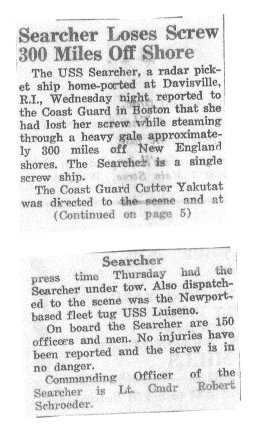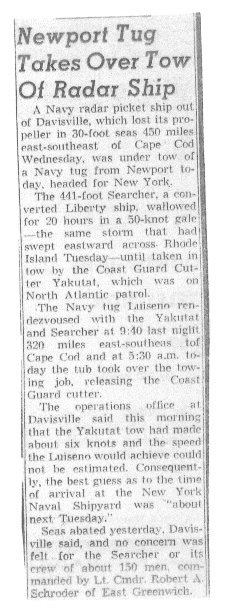Two articles from local newspapers on the lostscrew incident
Submitted by Jim Ashworth


USS Searcher (AGR-4)
How A Tailshaft And Screw Were Lost
By Strafford (Stretch) Moss
(AGR-11)
Copied from YAGRGRAM #23 - Harry Miller Editor
The new Atlantic Coast overhaul cycle for AGRs started in 1961. GUARDIAN (AGR-1) went into the yard first., followed by PROTECTOR (AGR-11) in late fall 1961. As Engineering Officer on PROTECTOR I was both busy and totally fascinated by the process. Upon release from active duty in June 1961, I went to work at the Bethlehem Steel Company's East Boston Yard where we had been dry docked. As the youngest supervisor, and just off active service, I was assigned to most of the smaller dollar value Navy jobs coming into the yard.
In early 1963 SKYWATCHER (AGR-3) came through the cycle, then in the fall, SEARCHER. On dry dock, certain grave formalities must be gone through. For the AGRs one of these was the removal of the propeller from the tail shaft, checking the stern tube bearing for excessive wear, and checking the shaft keyway to ensure that the key had been "spooned". "Spooning" was very important as it was a method of insuring that stress concentrations would not be initiated in the key way. Slightly more than 100 of the 2700+ Liberty Ships built had lost propellers from tail shaft failure. Analysis by the American Bureau of Shipping indicated a critical vibration speed of about 102-105 RPM when the propeller came partially uncovered in a seaway and many shafts had broken starting at keyway stress points. To minimize the possibility of failure, The Navy limited the AGRs engine speed to 66 RPM, reduced from design full speed of 76 RPM. Stern tube clearances were acceptable and a visual check of the shaft taper showed "spooning" had been accomplished and the shaft had no apparent cracking. As a final test, the shaft taper was magnetic particle tested. A heavy coil of insulated cable attached to a large storage battery was wrapped around the taper, forming an electromagnet. The area to be tested (the keyway), was sprinkled with a magnetic powder. The powder would orient itself in the form of distinct lines, showing any cracks. The test showed no cracking, but the cable ends drew a large arc on the polished taper creating a large gouge on the machined surface. The mechanics assured me that everything was "all right" and that they would polish the surface with a stone before reinstalling the propeller. "Dumbo" bought the explanation. In fact, smoothing the surface had not corrected the stress concentration point that the gouge had created in the shaft itself.
Out of dry dock SEARCHER went off to complete her
overhaul. In March 1964, SEARCHER lost her screw at sea. The news
made the Boston media. I wondered what had happened: everything had
seemed just fine when we had inspected the shaft. In 1964 I left Bethlehem
to work for an engineering company. A course of sprouts on nondestructive
testing was required in 1970, including magnetic particle testing. As the
instructor spoke, my mind went back to the SEARCHER. It was very clear
what had happened and that I had caused the propeller loss. Not a happy
day. I called my friend the lead civilian at the office of the Supervisor
of Shipbuilding Inspection and Repair at the Boston Navy Yard. He agreed
with my analysis. His take on the situation was interesting. I had
learned a lesson, no one had been hurt, another "mystery of the deep"
had been solved, and finally the AGRs had been laid up for at least five years
and would not be used again.
Two articles from local newspapers
on the lostscrew incident
Submitted by Jim Ashworth


The article on the left said "the screw is in no
danger".
Do you you think they really meant the crew was in no danger?
Back to USS Searcher Home Page